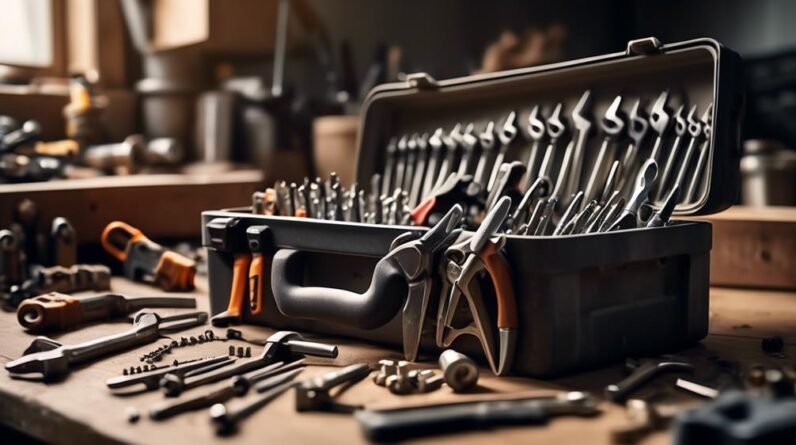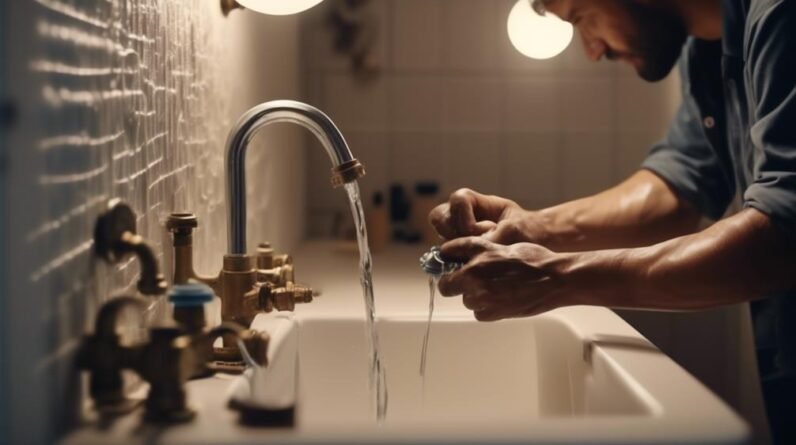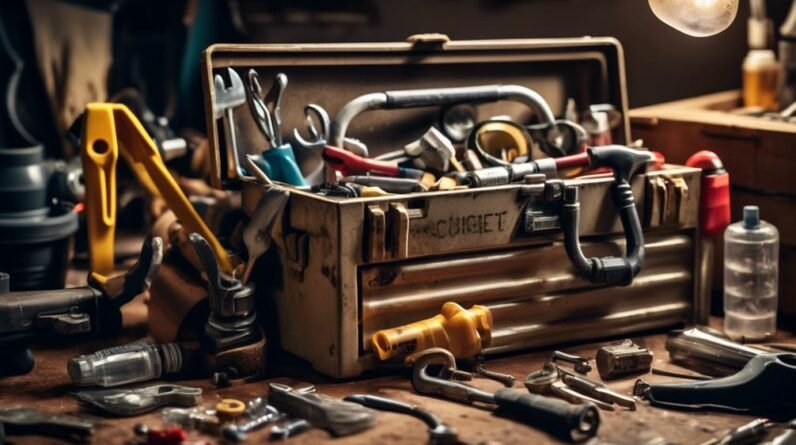
Tired of spending countless hours and a small fortune on home repairs? Look no further! We have the ultimate collection of quick and easy home repair hacks that will save you time, money, and a whole lot of frustration. From fixing leaky faucets to patching up holes in the wall, we've got you covered. But that's not all! We'll also show you how to unclog drains, repair squeaky doors, and even share some painting hacks that will transform your space. Get ready to become a DIY master and take control of your home's repairs with these simple yet effective tricks. So, what are you waiting for? Let's get started!
Key Takeaways
- Leaky faucets can be fixed by replacing faulty faucet handles or worn-out faucet cartridges.
- Patching up holes in walls involves cleaning the area, applying spackle, and sanding and painting for a seamless finish.
- Unclogging drains can be done using a plunger or a drain snake, and preventive measures like using boiling water or vinegar and baking soda can help keep drains clear.
- Squeaky doors can be repaired by lubricating hinges, tightening screws, and adjusting door alignment if necessary.
- When painting, consider paint colors that match the desired mood and use proper techniques like wall preparation, smooth application, and allowing each coat to dry fully before applying another.
Fixing a Leaky Faucet
Are you tired of the constant drip-drip-drip of a leaky faucet? Don't worry, fixing a leaky faucet is easier than you might think. The most common cause of a leaky faucet is a faulty faucet handle or a worn-out faucet cartridge. To fix the faucet handle, start by turning off the water supply under the sink. Then, use a screwdriver to remove the handle and inspect it for any cracks or damage. If the handle is damaged, you can easily replace it with a new one from your local hardware store. On the other hand, if the handle is in good condition, the issue might lie with the faucet cartridge. To replace the faucet cartridge, start by removing the handle and unscrewing the cartridge. Then, take the old cartridge to the store to find a replacement that matches it. Finally, install the new cartridge by reversing the steps you took to remove the old one. Remember to turn the water supply back on and test the faucet to ensure the leak is fixed. With these simple steps, you'll be able to say goodbye to that annoying drip-drip-drip and enjoy a fully functional faucet once again.
Patching up a Hole in the Wall
If you've successfully fixed that annoying leaky faucet, it's time to tackle the next home repair task: patching up a hole in the wall. Don't worry, it's easier than it sounds. Here are three quick and easy steps to fix that unsightly hole in your wall:
- Prepare the area: Start by cleaning the hole and removing any loose debris. Use a putty knife to scrape away any flaking paint or loose drywall around the edges of the hole. This will ensure that the patch adheres properly.
- Apply the spackle: Take a small amount of spackle on your putty knife and apply it to the hole. Use a smooth, even motion to fill the hole completely. Be sure to feather the edges of the spackle to blend it seamlessly with the surrounding wall.
- Sand and paint: Once the spackle has dried, use fine-grit sandpaper to smooth out any rough edges. Then, apply a coat of primer and let it dry. Finally, paint the patched area to match the rest of the wall.
With these simple drywall repair and spackling techniques, you'll have that hole in your wall fixed in no time. Don't let it be an eyesore any longer – take action and restore the beauty of your home.
Unclogging Drains
To unclog drains effectively, follow these simple steps. First, start by using a plunger to create suction and dislodge the clog. Place the plunger over the drain, ensuring a tight seal, and vigorously push and pull to create pressure. Repeat this process a few times until the water starts to drain properly. If the plunger doesn't work, try using a drain snake. Insert the snake into the drain and rotate it clockwise while pushing it forward. This will help break up the clog and allow it to be removed. Once the clog is cleared, it's important to take steps to prevent future clogs. One effective method is to regularly pour boiling water down the drain to flush out any buildup. Additionally, using a mixture of vinegar and baking soda can help keep drains clear. Simply pour a cup of baking soda followed by a cup of vinegar down the drain, wait for a few minutes, and then flush with hot water. These simple DIY drain cleaning tools and preventive measures will help keep your drains running smoothly and avoid costly repairs.
Repairing Squeaky Doors
Repair squeaky doors easily with these simple steps. Follow these three easy tips to eliminate annoying door squeaks and restore your peace and quiet at home:
- Lubricate the hinges: Apply a small amount of lubricant, such as WD-40 or silicone spray, to the hinges. Use a rag or a cotton swab to ensure the lubricant is evenly spread over the hinge pins and moving parts. This will reduce friction and eliminate the squeaky noise.
- Check and tighten the screws: Over time, the screws that hold the hinges in place may become loose, causing the door to squeak. Inspect the screws and tighten them using a screwdriver. Be careful not to overtighten, as this could strip the screws or damage the door frame.
- Adjust the door alignment: If the squeak persists, the door may be misaligned. Use a level to check if the door is straight. If it isn't, loosen the screws on the hinges slightly and adjust the door until it is level. Retighten the screws once the door is properly aligned.
Painting Hacks
Now let's move on to painting hacks to give your home a fresh new look and continue improving its overall appearance. When it comes to choosing the right paint colors, there are a few tips that can help you make the best decision. First, consider the mood you want to create in each room. Warm colors like reds and oranges can create a cozy and inviting atmosphere, while cool colors like blues and greens can promote a sense of calmness and relaxation. Additionally, consider the lighting in each room. Natural light can enhance certain colors, while artificial light can affect how colors appear. It's also important to test paint samples on your walls before committing to a color. This will allow you to see how the color looks in different lighting conditions and how it complements your existing furniture and decor.
To achieve a smooth paint finish, there are a few techniques that can make a big difference. First, ensure that your walls are properly prepared by cleaning them and filling any holes or cracks. Sanding the walls before painting can also help create a smooth surface. When applying the paint, use long, even strokes and avoid overloading the brush or roller. This will help prevent visible brush marks or roller lines. It's also a good idea to invest in high-quality paint and tools, as they can make the application process easier and result in a better finish. Finally, be patient and allow each coat of paint to dry fully before applying another one. This will help prevent smudging or streaking.
Frequently Asked Questions
How Can I Remove Hard Water Stains From a Faucet?
To remove hard water stains from a faucet, mix equal parts vinegar and water in a spray bottle. Spray the solution onto the stains and let it sit for a few minutes before scrubbing them away with a toothbrush.
What Are Some Common Causes of Holes in Walls and How Can I Prevent Them?
Common causes of wall holes include accidental damage, hanging heavy objects, and pests. To prevent them, be cautious when moving furniture, use proper hanging techniques, and seal any cracks or holes promptly.
What Are Some Natural Methods for Unclogging Drains Without Using Chemical Products?
To unclog drains naturally, try DIY drain cleaning techniques. Use a mixture of baking soda and vinegar, followed by hot water. Another option is using a plunger to create suction and dislodge the clog.
How Can I Fix a Door That Is Sticking and Making Squeaky Noises?
To fix a sticking and squeaky door, start by lubricating the hinges with WD-40 or a silicone-based lubricant. Tighten any loose screws on the hinges or door frame to ensure a secure fit.
Are There Any Tips for Choosing the Right Paint Color for a Room?
When choosing paint colors for a room, consider the mood you want to create. Create a cohesive color scheme by using complementary or analogous colors. Don't forget to test the colors on your walls before committing.
Conclusion
In conclusion, these quick and easy home repair hacks can save you time, money, and frustration. By fixing a leaky faucet, patching up a hole in the wall, unclogging drains, repairing squeaky doors, and using painting hacks, you can easily tackle common household issues. With these practical tips, you can maintain a well-functioning home and avoid the need for costly professional repairs. So roll up your sleeves and get ready to become a handy DIY expert!







